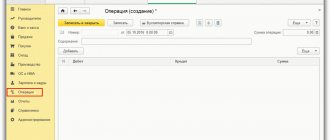General accounting procedure for off-balance sheet budget accounts
The list of standard off-balance sheet accounts is approved by Instruction No. 157n:
- from 1 to 27, as well as 29–31, 33, 38–40, 42, 45 and 53.
The instructions do not limit the right of the institution to use additional off-balance sheet accounts, but they must be agreed upon with the founder and approved in the accounting policy. Irregularities in accounting for off-balance sheet accounts distort reporting, which can result in fines.
- A simple accounting scheme is applied to all off-balance sheet accounts: receipts are reflected only as a debit, and disposals as a credit, without correspondence.
- Data on off-balance sheet accounts does not have to be reflected in the journals of transactions and the General Ledger.
- All material assets and other assets and liabilities that are recorded on off-balance sheet accounts are inventoried in the manner and within the time limits established for objects recorded on the balance sheet.
Receipt of spare parts
According to the Instructions for budget accounting (approved by order of the Ministry of Finance of Russia dated December 30, 2008 No. 148n, as amended on December 30, 2009 No. 152n, hereinafter referred to as Instruction No. 148n), material assets issued for vehicles to replace worn-out ones (batteries, tires and etc.) in order to control their use are recorded in off-balance sheet account 09 “Spare parts for vehicles issued to replace worn-out ones.” Material assets are reflected in accounting at the time of their write-off for the purpose of repairing vehicles and are taken into account during the period of their operation (use) as part of the vehicle.
The write-off of material assets from off-balance sheet accounting is carried out on the basis of an acceptance certificate for completed work, confirming their replacement.
Analytical accounting of the account is maintained in the Card of quantitative and total accounting (f. 0504041) in quantitative terms, indicating the position and surname of the recipient, date of receipt, serial number.
According to the Instructions on the procedure for applying the budget classification of the Russian Federation, approved by Order of the Ministry of Finance of Russia dated December 30, 2009 No. 150n, the institution’s expenses for paying for contracts for the purchase of spare parts are included in Article 340 “Increase in the cost of inventories” of the classification of operations of the general government sector.
Therefore, spare parts should be accounted for as part of inventories on account 0 105 06 000 “Other inventories”.
If a purchase by a budgetary institution was made within the framework of one contract (purchase, delivery, loading and unloading, etc.), then spare parts are taken into account immediately to account 0 105 06 000 “Other inventories”:
Debit KRB 0 105 06 340 Credit KRB 0 302 22 730.
In the program “1C: Accounting of a budgetary institution 8”, the posting of spare parts is formalized by the document Purchase of materials.
Reflection of transactions in the first group
If an institution needs to reflect the current year’s expenses according to the corresponding expense type code (KVR), then in parallel with reflecting the outflow of funds from the personal account or the outflow of cash from the cash register, it is necessary to generate a posting to the credit account 18.01 or 18.34 according to the corresponding analytical expense code.
Example.
Using funds to complete a government assignment, Institution A purchased inventories from a supplier. Payment was made by transfer to the supplier's account.
In the program "1C: Public Institution Accounting 8", ed. 1, it is necessary to generate the document “Request for cash expense”, “Cash expense order” or “Cash disposal”, during which the accounting records will be reflected:
Debit 4.00000000000000244.302.34 – Credit 4.00000000000000000.201.11.610
Credit 4. 00000000000000244.18.01.340
Based on these records in f. 0503737 in section 2 “Institutional expenses”, column 5 “Through personal accounts” under expense type code 244 “Other purchase of goods, works and services to meet state (municipal) needs” this amount will be reflected. The scheme for reflecting the expenses of an institution for the current year, executed through a personal account, is universal for other expense type codes, for example, such as “111- Payroll Fund”, “119 - Compulsory social insurance contributions for payments to employees and other payments to employees institutions”, “112-Other payments to personnel of institutions, with the exception of the wage fund”, etc.
Let's consider the reflection of cash expenses through the institution's cash desk. For example, an accountable person was given funds for the purchase of inventories:
Debit 4.00000000000000244.208.34 – Credit 4.00000000000000000.201.34.610
Credit 4. 00000000000000244.18.34.340
Credit 4. 00000000000000244.ND.340
In this case, the expense will fall into section 2 f. 0503737 column 7 “Through the institution’s cash desk” under KVR 244.
Also, in the practice of an institution, quite often it is necessary to restore the cash flow of the current year. In this case, section 2 f. 0503737 will be formed taking into account the restoration of such expenses.
Example.
Institution A transferred more wages to the employee than was required. The employee returned the funds to the institution's cash desk.
In this case, the following transactions will be generated:
Debit 4.00000000000000000.201.34.510 – Credit 4.00000000000000111.302.11
Debit 4. 00000000000000111.18.34.211
Credit 4. 00000000000000111.ND.211
If the expense is restored through the institution’s personal account, an additional entry is generated to the Debit account on 01/18/XXX according to the corresponding expense code.
Accounting for the institution's property
- Account 01 “Property received for use”
The account takes into account the property that the institution has received for use, but these are not rental objects:
- assets that, by decision of the founder, the institution uses without securing the right of operational management;
- values that, according to the law, are not reflected on the balance sheet of the institution: museum objects and collections included in the state part of the Museum Fund of the Russian Federation, rights to limited use of other people's land plots.
Such property is registered under a transfer and acceptance certificate or other document that confirms receipt of the property and rights to it. Assets are reflected at the cost indicated in the documents.
Accounting is carried out in the context of property objects, owners (balance holders), locations of objects, responsible persons, legal grounds, KOSGU, as well as by inventory, serial and register numbers.
- Account 02 “Material assets accepted for storage”
In addition to the property that the institution received for storage, account 02 now needs to take into account:
- material assets that do not meet the criteria of assets;
- property in respect of which a decision has been made to write off until it is dismantled, disposed of or destroyed.
Material assets in storage or for processing are taken into account on the basis of a primary document that confirms their receipt: an acceptance certificate, a contract, etc.
Objects are reflected at the cost specified in the primary document. If the institution executed the act unilaterally, the valuation is: one object, one ruble.
Material assets that do not meet the asset criteria on account 02 are also reflected in the conditional valuation: one object, one ruble.
The disposal of MCs from off-balance sheet accounting is reflected on the basis of supporting documents at the cost at which they were accepted for off-balance sheet accounting.
In the quantitative and total accounting card, the object accepted for storage or processing is reflected in the context of owners (customers), by type, grade and storage location.
Analytical accounting is carried out in the context of property objects and their locations, responsible persons, owners, possessors, other persons, and legal grounds.
- Account 05 “Material assets paid for by centralized supply”
Accounting is maintained by the supply ordering institutions. Material assets are reflected according to documents that confirm the shipment to the consignee in the amount of payments for their purchase. Accounting is maintained in the inventory book for each consignee and type of property.
Courses for accountants
Professional retraining, advanced training. Online training at Kontur.School
Course Schedule
- Account 06 “Debt of pupils and students for unreturned material assets”
Debt is taken into account in the amount of expenses for restoration or acquisition of similar property. Accounting is carried out in the card for recording funds and payments by type of income, valuables, and students.
- Account 07 “Awards, prizes, cups and valuable gifts, souvenirs”
Prizes, banners, cups established by various organizations and received to reward winning teams are taken into account in an off-balance account during the entire period of stay in the institution.
Valuable gifts and souvenirs are reflected on the off-balance sheet account from the moment of issue from the warehouse or purchase, if they are not accepted into the warehouse, until delivery.
On account 07 property is accepted:
- in the conditional assessment, one item, one ruble - received awards, prizes, cups, banners;
- at the cost of acquisition - valuable gifts, souvenirs and material assets for rewarding.
Accounting is carried out in a quantitative-total accounting card for financially responsible persons, storage locations and each item. If responsible persons simultaneously submit documents on the acquisition and delivery of valuables, then they are not reflected in the off-balance sheet account. In this case, expenses of the current financial period are recognized in the amount of the cost of valuable gifts or souvenirs.
- Download 6 practical examples of accounting for off-balance sheet accounts of an institution at the end of the article in the “Crib Sheet” section.
There is a cheat sheet at the end of the article
- Account 09 “Spare parts for vehicles issued to replace worn-out ones”
Spare parts are accepted for off-balance sheet accounting at the time they are written off from the balance sheet for vehicle repairs and are taken into account during the period of operation as part of the vehicle. Accounting is kept in a quantitative-cumulative accounting card by persons who received spare parts, by vehicles and by type and quantity of spare parts.
The institution's accounting policy must contain a list of spare parts accounted for on an off-balance sheet account.
When a vehicle is retired, the spare parts installed on it and accounted for in account 09 are written off from off-balance sheet accounting.
- Account 12 “Special equipment for carrying out research work under contracts with customers”
Equipment is accounted for at the cost indicated by the customer in the primary transfer documents. Accounting is carried out in a quantitative and total accounting card in the context of work, responsible persons, storage locations, and by type and quantity of equipment.
- Account 13 “Experimental Devices”
Objects are registered at their cost, which is attributed to the increase in R&D costs. Accounting is carried out in a card of quantitative and total accounting in the context of responsible persons, storage locations by type, quantity and value of valuables.
- Account 21 “Fixed assets in operation”
The account keeps records of fixed assets worth up to 10,000 rubles. inclusive. The exception is real estate and library collections.
OS is registered according to the primary document when transferring an object up to 10,000 rubles. into operation.
Accounting is carried out at the cost established in the accounting policy:
- in conditional valuation - 1 rub. for one object or at book value.
Accounting is carried out in a card of quantitative and total accounting in the context of OS objects, responsible persons, locations, addresses.
Objects are written off from the account only by decision of the commission on the basis of an acceptance certificate or a write-off act.
- Account 22 “Material assets received through centralized supply”
Property that was received through centralized supply is registered until the notification (f. 0504805) and copies of the supplier’s documents are received.
- Account 24 “Non-financial assets transferred to trust management”
Objects are accepted for accounting on the basis of an acceptance certificate at the cost specified in the document.
- Account 25 “Property transferred for paid use (rent)”
The account is needed to account for non-operating (financial) and operating leases, in terms of the granted rights to use property transferred by the institution for paid use under a lease agreement.
- Account 26 “Property transferred for free use”
The account is intended to record data on leased objects on preferential terms, as well as on property transferred for free use without securing the right of operational management.
- Account 27 “Material assets issued for personal use to employees (employees)”
Off-balance sheet accounting includes uniforms, special clothing, fixed assets and other property issued by an institution for permanent personal use to employees for their official duties.
Accounting is carried out at book value on the basis of a primary document, in a quantitative and total accounting card, in the context of property users, locations, KOSGU, by type, quantity and value of property.
Off-balance sheet account 009
As a rule, business transactions are recorded using double entry. On the one hand, the debit indicates the receipt of funds and the same amount should be reflected in the credit account in another account - the loan. In other words, double entry reflects a clear movement of funds: Debit - Credit and a specific amount.
Important! Off-balance sheet accounts also have debits and credits. But their peculiarity is that the recording is made by one-way wiring. That is, there is no need to simultaneously reflect the same amounts in the debit of one account and in the credit of another.
Account 009 allows you to see transactions on issued funds. These transactions indicate how payments are made and how obligations are secured. This off-balance sheet account summarizes information on valuables that are at the temporary disposal of the company, either temporarily stored in the company or being processed.
Off-balance sheet accounts are necessary for more careful, more thorough accounting. Therefore, they are subject to constant adjustment by legislative acts.
According to accounting terminology, the balance sheet asset contains only the organization's own funds. But quite often a company can use other people’s funds. Special accounting is most convenient for creditors, since it allows the calculation of liquid coverage with accounts payable. Creditors were asked to separate the company's own property in accounting from property that does not belong to it. Thus, the company's property is listed on the company's balance sheet asset, and property not owned by the company remains off the balance sheet. For this purpose, account 009 was created, which is called “Security for obligations and payments issued.” This account shows the write-off of the company's borrowed funds upon repayment. This register is intended to record each security issued.
Accounting for money, settlements and settlement documents
Money, settlements and settlement documents are taken into account from the 14th to the 19th and on the 30th off-balance sheet accounts.
- Account 14 “Settlement documents awaiting execution” and account 15 “Settlement documents not paid on time due to lack of funds in the account of a state (municipal) institution)”
On the 14th account, unpaid documents of the financial authority are taken into account. On account 15 - presented payment and collection orders for payments to budgets, judicial writs of execution of the body providing cash services, institutions.
Documents are kept in the accounting card for settlement documents awaiting execution, broken down by accounts for each document.
- Account 16 “Overpayments of pensions and benefits due to incorrect application of legislation on pensions and benefits, accounting errors”
Keep records in the Funds and Settlements Accounting Card. Registration is carried out according to acts of audits, inspections and other similar documents.
In account 16, the amounts of overpaid benefits continue to be recorded until they are repaid or written off.
If the repayment or collection is carried out over several months, the amounts recorded off balance may also be written off gradually.
- Account 17 “Cash receipts” and account 18 “Cash outflows”
Accounts must be opened for balance sheet accounts:
- 201 00 “Institutional funds”;
- 210 03 “Settlements with the financial authority for cash”;
- 304 06 “Settlements with other creditors” (in terms of cash settlements).
Accounting is carried out in a multi-graph card or a card for recording funds and settlements in the context of institution accounts, by type of disposals and receipts, in the context of KOSGU, types of currencies.
At the end of the year, account balances are not carried over to the next year. That is, accounts 17 and 18 must be closed on December 31 of the reporting year.
- Account 19 “Unexplained receipts from previous years”
The accounting of the amounts of uncleared revenues is carried out by financial authorities, bodies of the Federal Treasury or the chief administrators of budget revenues according to the dates of enrollment and the dates of their clarification.
- Account 30 “Settlements for the fulfillment of monetary obligations through third parties”
The account is used to record settlements when paying pensions and benefits through Russian Post offices or paying agents. Analytical accounting is maintained in a multi-graph card or a card for accounting for funds and settlements in the context of monetary obligations by type of payment of budget funds or other payments.
Reflection of transactions in the second group
If an institution needs to reflect the receipt of income for the current year according to the corresponding analytical income code, then in parallel with the reflection of the receipt of funds to the personal account or the receipt of cash at the institution's cash desk, it is necessary to generate a posting to the debit account 17.01 or 17.34.
Let us consider the situation in which Institution A receives income from the provision of paid services. To reflect this business transaction in the program “1C: Accounting of a State Institution”, ed. 1.0, you can generate documents “Cash receipt” or “Cash receipt order”. When posting a document, the following transactions will be reflected:
Debit 2.00000000000000000.201.11.510 (201.34) – Credit 2.00000000000000130.205.31
Debit 2. 00000000000000130.17.01.130
Loan 2. 00000000000000130.ND.130 (in case of generating income to the institution’s cash desk)
The amount for this operation will fall into section 1 “Institutional Income” f.0503737 in the corresponding column 5 or 7 according to analytical income code 130. If the institution is obliged to return the excess income from sales (document “Cash Receipt”, “Request for Refund” ) the reflection of operations will be as follows:
Debit 2.00000000000000130.205.31 – Credit 2.000000000000000000.201.11.610 (201.34)
Credit 2.00000000000000130.17.01.130
Credit 2.00000000000000130.ND.130 (in case of generating a return of income through the institution’s cash desk)
Section 1 f. 0503737 will be formed based on data on receipt of income, taking into account their returns in the current year. This reflection of the institution’s income receipts and their return can also be used for other analytical income codes.
Accounting for receivables and payables
To record accounts receivable and payable on the off-balance sheet, two accounts are provided:
- Account 04 “Doubtful debts” and account 20 “Debt unclaimed by creditors”
Debt is reflected in accounting when the commission for the receipt and disposal of assets decides to write it off from the balance sheet, including if the debt does not meet the criteria for recognizing it as an asset.
Debt accounting is maintained in the card for accounting for funds and settlements:
- by type of revenue and debtor for accounts receivable;
- by types of payments, receipts and by creditors for accounts payable.
Analytical accounting is carried out in the context of classification codes for budget revenues, budget expenditures, sources of financing budget deficits, counterparties, and financial support codes.
From account 04, the debt is written off by decision of the commission (in the event of death or liquidation of the debtor), when the debt collection procedure is resumed, or, if money has been deposited into the account, to repay the debt.
Reflection of transactions in the third group
In these operations, it is necessary to take into account that additional postings to off-balance sheet accounts are generated not only to account 201.11 and 201.34, but also to account 210.03. Transactions on the movement of cash between the cash register and the personal account fall into section 3 “Sources of financing the deficit of the institution’s funds” in lines 710, 720 (as “total turnover” on accounts 201.11 and 210.03) and in lines 731 and 732 (as “internal turnover "between the accounts and the cash register).
Example.
Institution A has withdrawn cash from the personal account.
This operation can be formalized with the document “Cash Request”, “Cash Retirement”. Account records will be generated:
Debit 4.00000000000000000.210.03 – Credit 4.00000000000000000.201.11.610
Credit 4.00000000000000000.17.01.610 (posting to account 201.11, pay attention to KEC 610)
Debit 4.00000000000000000.17.30.510 (posting to account 210.03, pay attention to KEK 510)
Next, the funds go to the institution’s cash desk. The operation must be reflected in the document “Cash receipt order”:
Debit 4.00000000000000000.201.34.510 – Credit 4.00000000000000000.210.03
Credit 4.00000000000000000.17.30.610 (posting to account 210.03, pay attention to KEC 610)
Debit 4.00000000000000000.17.34.510 (posting to account 201.34, pay attention to KEC 510)
Pay attention to the KEC “510 – receipts to budget accounts” and “610 – disposal from budget accounts” used for accounts 17.XX.
Incorrectly specified KEK in postings will affect the internal control ratio f. 0503737.
How to write off materials from an off-balance account
For non-profit organizations, typical transactions will be as follows:
- Dt 002 - acceptance of materials for safekeeping;
- Kt 002 - write-off of previously accepted materials.
For a budget organization, fixed assets worth up to 10,000 rubles. reflected in off-balance sheet accounts 21 (clause 373 of Instruction No. 157n as amended on March 31, 2018).
The accounting entry for writing off the object will be as follows: Kt 21 - the fixed asset object is written off off the balance sheet.
Did the article help? Share it on social networks. This is the easiest way to thank us for our work.
About the author of the article
Zadorozhneva Alexandra
Accountant
In 2009, she graduated with a bachelor's degree from the Faculty of Economics of Southern Federal University, majoring in economic theory. In 2011, she completed her master’s degree in Economic Theory and defended her master’s thesis.
Other articles by the author on gosuchetnik.ru
The article was prepared using materials from ConsultantPlus. Get access The article was prepared using materials from ConsultantPlus. Get access
Along with this material, people often search for:
The order of payments in a payment order is a special payment detail that is used to establish the order in which money is written off. Find out how to define it and where to enter it.
February 23, 2019
The amount of income tax in 2021 is 13% from wages or other income of a resident or 30% from earnings and other income in Russia in favor of a non-resident of the Russian Federation. Talk about increasing personal income tax in the State Duma does not subside. They plan to raise it to 15%.
December 20, 2019
The personal account of the payer of insurance contributions to the Pension Fund is, in fact, an online service for calculating and paying payments to the Pension Fund. We will tell you what functions it performs and how to register an organization.
December 18, 2018
A time-based wage system is when an employee receives remuneration for performing his job duties depending on the amount of time worked. Let's look at the key features of time-based payment and how it is calculated.
June 13, 2018
Weekly newsletter
Every Monday you will receive a selection of the most interesting materials from the past working week
Calculation of insurance premiums and their posting | Payment of insurance premiums to extra-budgetary funds
All employers pay insurance contributions for pension, health and social insurance.
Part of the contributions (pension, medical and social benefits in case of illness and maternity) is paid in different payments to the tax office.
And only social contributions for social insurance against accidents and occupational diseases are still transferred to the Social Insurance Fund. In this article we will tell you how to calculate contributions, what transactions to create and take them into account in tax accounting.
Calculation of insurance premiums: postings, features
Insurance premiums in accounting are calculated monthly by employing organizations in the month to which the contributions relate. Insurance premiums from vacation pay are calculated along with them.
According to the Labor Code of the Russian Federation, vacation pay must be issued to the employee no later than three days before the start of the vacation.
This means that insurance premiums for the entire amount of vacation pay must be accrued simultaneously with vacation pay, even if the vacation began in one reporting period (billing period) and ended in another.
To account for insurance premiums, the chart of accounts has 69 accounts and subaccounts to it.
Second-order subaccounts are opened for first-order subaccounts in order to separately allocate contributions for pension and health insurance, as well as contributions for illness and maternity and contributions for industrial accidents. Accrued contributions are reflected on the credit of these subaccounts in correspondence with the debit of the cost accounting accounts:
Debit 20 (25, 26, 44 ...) Credit 69 sub-account “OPS” - pension contributions have been accrued;
Debit 20 (25, 26, 44 ...) Credit 69 subaccount “Calculations for medical contributions” - contributions for medical insurance have been accrued;
Debit 20 (25, 26, 44 ...) Credit 69 subaccount “Calculations for contributions in case of temporary disability and maternity” - contributions in case of temporary disability and maternity have been accrued;
Debit 20 (25, 26, 44 ...) Credit 69 subaccount “Settlements with the Social Insurance Fund for contributions from accidents and occupational diseases” - insurance premiums to the Social Insurance Fund of the Russian Federation for accidents at work have been accrued.
Reflection of payment of insurance premiums
Paid contributions are reflected in the debit of subaccounts of account 69 “Calculations for social insurance and security” and the credit of account 51 “Current account”:
Debit 69 sub-account “OPS” Credit 51 “Current account” - contributions to the insurance part of the pension have been paid;
Debit 69 subaccount “Calculations for medical contributions” Credit 51 “Current account” - medical contributions have been paid;
Debit 69 subaccount “Calculations for contributions in case of temporary disability and maternity” Credit 51 “Current account” - contributions in case of temporary disability and maternity have been paid;
Debit 69 “Settlements with the Social Insurance Fund for contributions from accidents and occupational diseases” Credit 51 “Current account” - insurance premiums were paid to the Social Insurance Fund of the Russian Federation for accidents at work.
Tax accounting of insurance premiums
If you work for OSNO, then expenses in the form of insurance contributions for compulsory pension, social and health insurance are taken into account as part of other expenses. The same applies to contributions accrued for payments that are not included in corporate income tax expenses.
If you work for the simplified tax system or UTII, insurance contributions reduce the tax base in the following cases:
- The individual entrepreneur applies the simplified tax system and/or UTII and does not make payments in favor of individuals;
- The company applies the simplified tax system on the basis of “income minus expenses”.
50% of insurance premiums are accepted to reduce the amount of tax paid in connection with the application of the special regime in the following cases:
Insurance premiums do not reduce the cost of a patent.
Payment orders for the transfer of insurance premiums
From March 31, 2014, when transferring current taxes and contributions, field 22 of the UIN is entered as 0. If field 22 is empty, the payment order at the bank will not be executed.
In field 101 of payments for contributions to both the Pension Fund and the Social Insurance Fund, status 08 is entered. In fields 106, 107, 108, 110, when paying insurance premiums, 0 is entered.
There is a special order in field 8 for IP, where the IP address is now indicated via //.
Particular attention should be paid to filling out the “KBK” field.
Due to an error in this information, the payment may be returned back to the sender's bank account, or insurance premiums may be credited incorrectly or end up in outstanding payments. In these cases, the deadlines for payment of contributions may most likely be violated.
Fines and penalties for insurance premiums
According to Art. 25 of Law No. 212-FZ of July 24, 2009, if monthly payments for insurance premiums were transferred later than the established deadlines, regulatory agencies may charge the organization a penalty for each day of delay, at the rate of 1/300 of the refinancing rate.
Penalties for insurance premiums are not provided for by law, but the fines are quite significant.
Your company may be fined for not registering with extra-budgetary funds on time or for submitting reports on insurance premiums late or in an unspecified form. This is not an exhaustive list of fines to a company that an extra-budgetary fund can impose.





